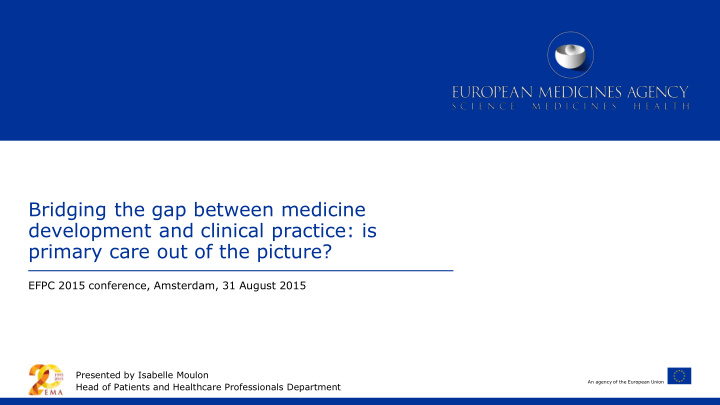



Bridging the gap between medicine development and clinical practice: is primary care out of the picture? EFPC 2015 conference, Amsterdam, 31 August 2015 Presented by Isabelle Moulon An agency of the European Union Head of Patients and Healthcare Professionals Department
Have we got anything in common? Clinical practice European Medicines Agency (EMA) 1
European Medicines Agency (EMA) What is the EMA role? • Evaluation of marketing authorisation for human and veterinary applications submitted by pharmaceutical companies • Coordination of European pharmacovigilance • Provision of scientific advice on the development of medicines • Evaluation of applications for orphan designation in EU • Evaluation of paediatric investigation plans (or waivers) • Evaluation of arbitration and referral procedures • Provision of comprehensive and independent information on medicines • Coordination of inspections (GMP, GCP, GLP) 2
Why do we need to talk to each other? To make sure that the decision we take is meaningful for your practice and have a positive impact on your patients 3
Example 1: Tysabri • Authorised since 2006 for the treatment of relapsing remitting multiple sclerosis (restricted population) • 2008/2009 reports of progressive multifocal leukoencephalopathy • TYSABRI therapy is to be initiated and continuously supervised by specialised physicians experienced in the diagnosis and treatment of neurological conditions, in centres with timely access to MRI. • Additional risk minimisation measures: Marketing Authorisation Holder to agree with the National Competent Authorities measures to enhance monitoring (e.g. registries, post- marketing surveillance studies); • Physician pack containing Summary of Product Characteristics and Package Leaflet, Physician information about TYSABRI, Patient alert card, Treatment initiation and treatment continuation forms. Which are GPs’ needs and involvement for such specialised therapy ( e.g. in term of patient’s information, monitoring or reporting)? 4
Example 2: Restrictions on use of codeine for pain relief in children • Reports of serious respiratory depression ‒ Most of the cases occurred after surgical removal of the tonsils or adenoids ‒ some of the children being ‘ultra - rapid metabolisers’ of codeine ‒ Cases in breastfeed infants • More limited information on PK in children than in adult Restrictions, including: • Indication in children >12 years for treatment of acute moderate pain • Contraindications in all paediatric patients after tonsillectomy and/or adenoidectomy, women during breastfeeding, patients known to be CYP2D6 ultra-rapid metabolisers 5
Example 2: Restrictions on use of codeine for pain relief in children CYP2D6: extensive polymorphism (> 100 different allelic variants) • • Ultra-rapid metaboliser (~1.9%) may experience exaggerated and even potentially dangerous opioid effects. • Assays are available to determine CYP2D6 genotype but recommendations were made after considering that no tests are available for routine screening of CYP2D6 polymorphism (yet). Which is the impact of new pharmacogenomics testing in clinical practice; availability, validity, interpretation, change in use of existing medicines, needs for related information (e.g. prevalence of relevant genotype/phenotype in different population)? 6
Example 3: Analysis using The Health Improvement Network (THIN) database (UK general practice) 91,112 children out of 2,515,938 in THIN were prescribed codeine during the study period. 289 deaths were reported in these children, with 10 deaths occurring within 14 days of codeine prescription but none of these had a reported cause of death related to codeine toxicity. 21,171 tonsillectomy , 7,317 adenoidectomy and 8,254 combined procedures. Codeine was prescribed in 9% of tonsillectomy and 0.5% of adenoidectomies (within +/- 7 days), with a prescription peak in the period 4 to 7 days post-operatively, which was considered relatively low, although it was noted that codeine prescribed at the hospital during the procedure or codeine given at the hospital is not captured by THIN. How could health record database best contribute to support post-marketing monitoring of safety and efficacy of medicines? 7
Example 4 Recommendations on: • Pragmatic trials • Electronic health records for pragmatic trials • Observational studies • Registries • Methods to control for confounding 8
Other challenges • Pharmacovigilance: reporting of adverse reactions • Prevention of medication errors • Patient empowerment- Access to information: a role for you? GPs empowerment: do you get the right information on medicines at the right time? Can we do more? Can we do better to support you? 9
Sharing experience, knowledge and data? • During development and evaluation of medicines • During post-authorisation marketing phase Where is the experience? Where is the knowledge? Where is the data? with you 10
Framework for interaction between the EMA and Network of European healthcare professional healthcare professionals organisations (‘eligible HCPOs’) EMA Healthcare Professionals Working Party 11
We need each other to achieve our common goal Clinical practice European Medicines Agency (EMA) We have a common goal: Promoting safe and rational use of medicines 12
EMA engagement with GPs, Pharmacists, Nurses is key in addressing public health challenges Are you ready for the journey? 13
Thank you for your attention Further information Isabelle Moulon – isabelle.moulon@ema.europa.eu European Medicines Agency 30 Churchill Place • Canary Wharf • London E14 5EU • United Kingdom Telephone +44 (0)20 3660 6000 Send a question via our website www.ema.europa.eu/contact Follow us on @EMA_News
Recommend
More recommend